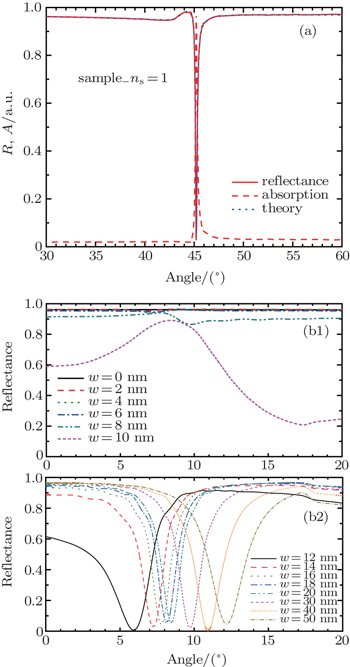† Corresponding author. E-mail:
Project supported by the National Natural Science Foundation of China (Grant Nos. 61137005 and 61178067), the Science Foundation of Shanxi Province, China (Grant No. 2013021004-3/2014021021-1), the Pre-studied Project on Weapon Equipment, China (Grant No. 201262401090404), and the Specialized Research Foundation for Doctor of School, China (Grant No. 20122027).
In this paper, a subwavelength metal-grating assisted sensor of Kretschmann style that is capable of detecting the sample with a refractive index higher than that of the substrate is proposed. The sensor configuration is similar to the traditional Kretschmann structure, but the metal film is pattered into a grating. As a TM-polarized laser beam impinges from the substrate, a resonant dip point in reflectance curve is produced at a certain incident angle. Our studies indicate that the sensing sensitivity and resolution are affected by the grating’s gap and period, and after these parameters have been optimized, a sensing sensitivity of 51.484°/RIU is obtained with a slightly changing resolution.
Surface plasmons (SPs) are electromagnetic waves that propagate along a conductor surface, whose electric field has a maximum at the surface and decays exponentially. SPs are excited generally through a coupling of an evanescent field generated by a TM-polarized light in attenuated total reflection (ATR).[1,2] Owing to the resonant condition, the excited SP that is very sensitive to the variation in refractive index of the surrounding environment. ATR offers a potential for exploring a sensor based on surface plasmon resonance (SPR). Over recent decades, since the dramatic progress made in micro-nano-fabrication technology,[3–5] ATR has became a useful tool in many areas, such as biology, chemistry, and environment.[6–9] The most commonly used setup of SPR sensor is the so-called Kretschmann,[10] in which a thin metal film is deposited on the base of a coupling prism and the sample is placed over the metal film. When we use a TM-polarized light that impinges from the base side at a certain incident angle, the light gets transferred to SP mode and will create a dip point in the reflectance curve. In order to make the sensor work in a sensitive and stable manner, till now, studying single or multilayer metal films (with different thicknesses, stacked positions, and compositions) on the resonant angle, spectrum and intensity have been reported.[11–14] The sample’s refractive index smaller than that of the base of setup is required for ATR, or it will not work. In some cases, given a sample with a high refractive index, to choose a base with a much higher refractive index is needed. However, because of a poor chemical stability and dispersive characteristics of the base introduced, such a method is unacceptable in practice. In the face of such a situation, it is necessary to restudy the basic mechanism and rule of the sensor based on SPR.
In this paper, an improved SPR sensor is proposed to investigate the sample with a refractive index higher than that of the base. The sensor configuration is similar to the Kretschmann, but the metal film has been patterned into a subwavelength-metal grating. We will study and summarize the performance of the sensor, more detailed information is organized as follows.
The designed sensor configuration is shown in Fig. 


At the very beginning of the studying, the simulation accuracy is evaluated by resorting to the sensor style of Kretschmann for h = 50 nm. In Fig.


 | Fig. 2. (a) The sensing properties of Kretschmann for h = 50 nm; (b1) and (b2) the reflectance for ns = 2 at different gap widths. |
As the sensor of Kretschmann is confronted with the challenge mentioned above, a feasible way of etching the metal film on it into a subwavelength grating is proposed. For learning its sensing characteristics in depth, the influence of reflectance on the grating’s gap width is studied for p = 260 nm first. In Fig.
 | Fig. 3. (a) Reflectance versus the grating thickness h for w = 18 nm, 8.2°; (b1) and (b2) the distribution of energy flux and the phase of Ez for h = 260 nm. |
Besides the gap effects, the effects of grating period on reflectance are shown in Fig.


 | Fig. 4. (a) Reflectance curves in different grating period p cases; (b) the comparison between the theoretical and simulated results. |
The dip in reflectance curve based on F–P resonance and SPR has been studied successively. Finally, with the optimized parameters of w = 18 nm and p = 260 nm, the sensing properties are discussed. For the reflectance curves shown in Fig.


A subwavelength metal-grating assisted sensor of Kretschmann has been proposed. With the study of the grating’s gap and period effects on reflectance, a cause of the dip point in reflectance curve based on F–P resonance and SPR has been proved. The sensor is able to work when the refractive index of a sample is smaller or higher than that of the substrate. A constant sensing sensitivity of 51.484°/RIU has given rise to the samples with refractive index higher than that of the substrate, and in the lower cases, the value gets higher. Our studies provide a guideline for sensing application based on the subwavelength-metal grating.
| 1 | |
| 2 | |
| 3 | |
| 4 | |
| 5 | |
| 6 | |
| 7 | |
| 8 | |
| 9 | |
| 10 | |
| 11 | |
| 12 | |
| 13 | |
| 14 | |
| 15 | |
| 16 | |
| 17 | |
| 18 | |
| 19 | |
| 20 |




